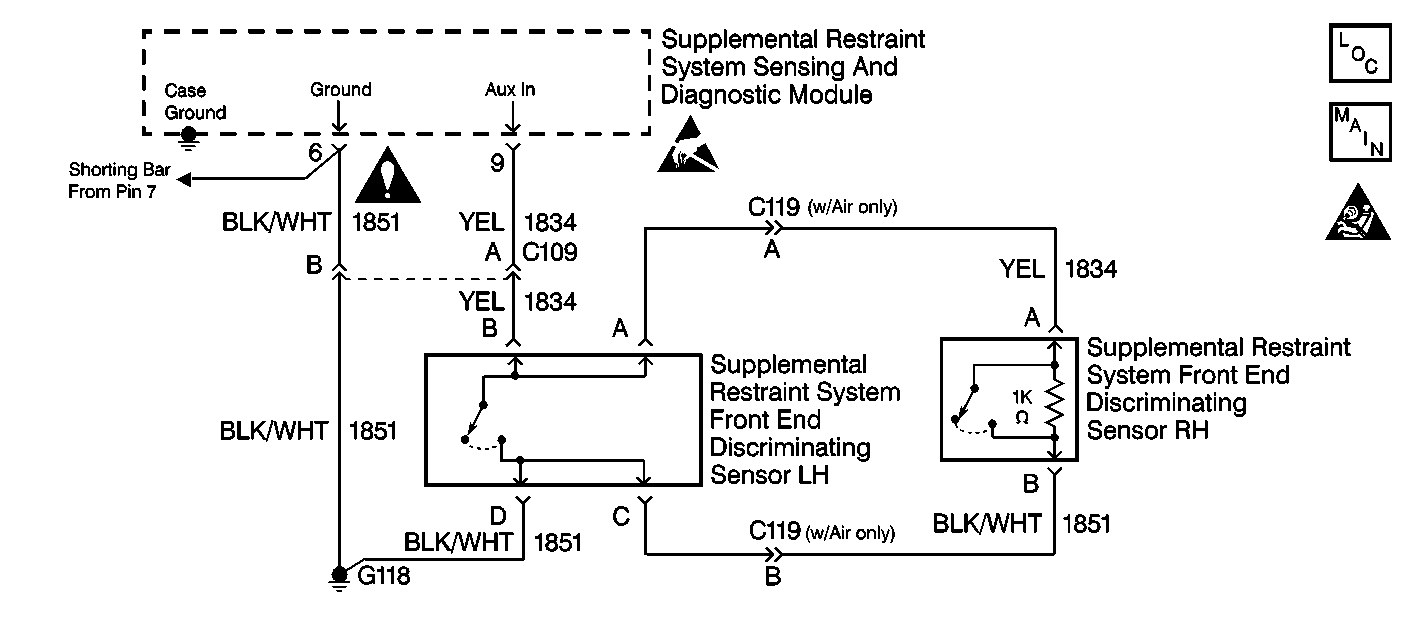
Circuit Description
When you first turn the ignition switch to the RUN position, the supplemental restraint sensing and diagnostic module (SDM) performs tests in order to diagnose critical malfunctions within itself. Upon passing these tests, the SDM measures the following circuits in order to ensure that they are within their respective normal voltage ranges:
| • | IGNITION 1 |
| • | 23 VLR |
| • | Deployment loop voltages |
The SDM proceeds to CONTINUOUS MONITORING. The SDM contains a resistor network connected to 5 volts, ground, and to the SDM front-end sensor signal terminal 9. The SDM monitors 2 front end discriminating sensors that are wired in parallel. The 1.0 K ohms resistor in the left supplemental restraint front end discriminating sensor parallel to the normally open switches in both sensors and provides a parallel path to ground. This causes a specified percentage of voltage to appear at the SDM front-end sensor signal input. The SDM monitors this voltage in order to detect shorts to ground or a closed discriminating sensor.
Conditions for Setting the DTC
| • | The SDM is configured for an supplemental restraint front end discriminating sensor. |
| • | The voltage at the front-end sensor signal terminal 9 is less than 0.5 volts for 500 milliseconds. |
The CONTINUOUS MONITORING test inspects for this DTC. This test occurs when IGNITION 1 is within the normal operating voltage range.
Action Taken When the DTC Sets
| • | The SDM sets a diagnostic trouble code. |
| • | The SDM turns the AIR BAG warning lamp to the ON position. |
Conditions for Clearing the DTC
| • | Current DTC |
| The voltage at the front-end sensor signal terminal 9 is more than 2.4 volts for 500 milliseconds. |
| • | History DTC |
| - | You issue a scan tool CLEAR CODES command. |
| - | After 250 malfunction free ignition cycles have occurred. |
Diagnostic Aids
A short to ground in the supplemental restraint front end discriminating sensor circuit may cause an intermittent condition. Inspect CKT 1834 carefully for cutting or chafing.
When measurements are requested in this table, use J 39200 Digital Multimeter with the correct terminal adapter from J 35616 Connector Test Adapter Kit. When an inspection for proper connection is requested, refer to Intermittents and Poor Connections . When a wire, connector or terminal repair is requested, use J-38125 Terminal Repair Kit and refer to Wiring Repair .
Test Description
The numbers below refer to the step numbers on the diagnostic table:
-
This test inspects for a malfunctioning discriminating sensor.
-
This test inspects for a short to ground in CKT 1834.
-
This test isolates the short to ground in CKT 1834 to one side of C109.
Step | Action | Value(s) | Yes | No |
|---|---|---|---|---|
1 | Was the SRS Diagnostic System Check performed? | -- | Go to Step 2 | |
Is the resistance reading more than the specified value? | 950 ohms | Go to Step 3 | Go to Step 6 | |
3 |
Is the resistance reading less than the specified value? | OL | Go to Step 6 | Go to Step 4 |
4 | With both sensors disconnected, measure the resistance between either sensor harness connector terminal A to ground. Is the resistance reading less than the specified value? | OL | Go to Step 5 | Go to Step 7 |
5 | Repair a short to ground condition in CKT 1834 between the two front end discriminating sensor harness connectors. Is the repair complete? | -- | Go to Step 11 | -- |
6 | Replace the malfunctioning supplemental restraint front end discriminating sensor. Refer to Supplemental Restraint Front End Discriminating Sensor Replacement . Is the repair complete? | -- | Go to Step 11 | -- |
Is the resistance reading less than the specified value? | OL | Go to Step 8 | ||
Is the resistance reading less than the specified value? | OL | Go to Step 9 | Go to Step 10 | |
9 | Repair a short to ground condition in CKT 1834 between C109 and the sensor harness connector. Is the repair complete? | -- | Go to Step 11 | -- |
10 | Repair a short to ground condition in CKT 1834 between C109 and the SDM harness connector. Is the repair complete? | -- | Go to Step 11 | -- |
11 |
Have all the SRS components been reconnected and properly mounted? | -- | Go to Step 12 | -- |
12 | Clear all the SRS DTCs. Have all the SRS DTCs been cleared? | -- | -- |
